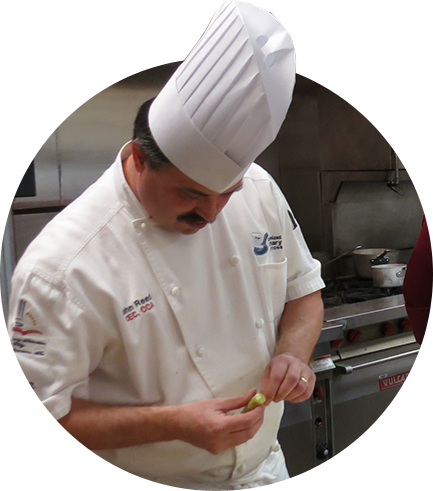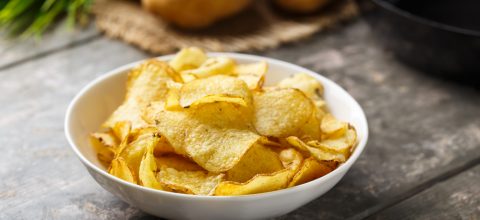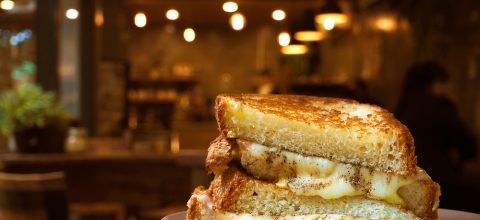Civet, a braised rabbit dish, is one of my favorite to prepare when I get a chance. It requires some old-school techniques as well as some skill and perfect timing to master. Look up Civet de Liêvre, Escoffier Recipe #1821 for those who are really “geeky” and want to check my facts. A civet is a braised dish usually made with hare with a sauce finished with a liaison of fresh blood.
When “whole hog” butchery was normal, animals may have been brought to the kitchen in a state of rigor with little or no field dressing. The processing of small game and birds was normally done in-house. The blood of hares was drained and reserved. Blood, as we know from the scratches and cuts we have had, coagulates well. In preparing a civet, which can be also done with other animals (such as venison and grouse), there are several steps involved, but the finishing of the sauce at the end is where the skill of mastering time and temperature comes into play. If the sauce is done too early or not at the right temp, it won’t thicken, or it will curdle if too hot.
It was my pleasure (and sometimes, my misfortune) to have worked with someone who used to like to put this dish on the menu the same night we had venison cut to order, squab, pheasant, and a few other fun things that had to be cooked whole to order or involved some intricate a la minute saucing procedure. I worked my butt off back in those days, but there were always those last few seconds at the plate up when you saw a sauce come together with gloss, sheen, viscosity, and above all, flavor that only can be made in an a la minute moment.
Sauce-making has become a lost art in many ways. We see a lot of reductions, foams, and creams that can made in advance and held. In most cases, sauces are even held in that beast of a machine called the steam table. It is more akin to a sauce dehydrator. Next time you order that meatloaf or steak with that red wine sauce, ask yourself, was it finished a la minute or ladled out of the sixth pan on the line.
When the culinary world made the leaps through cuisine from the first to the second Nouvelle Cuisine, Molecular and back again to something more recognizable , there was always a focus on taking out thickeners such as roux and the reduction of fats such as cream and butter. However, there is a very major drawback-we tend to lose the character of the sauces. It is this added richness that helps create an elegant restaurant dish. There was also the fact that this finishing of sauce with a fat or thickener such as blood also provided a luxurious mouthfeel and flavor to the dish. Sauce-making was the microgreen of the day. The saucier could make or break a kitchen.
I think that modern sauce-making techniques focused around deglazing and final liaisons still have merit. I am confident that my readers understand the concept of deglazing. However, it is the finishing of the sauce that is difficult to master unless you are working a line or doing some serious cooking at home. If you are, awesome!
I generally use the following process when making a sauce.
- Create a base sauce.
- Roast, sauté, braise, or stew an item to create caramelized flavors, capture them by deglazing, and add the base sauce.
- Reduce the sauce to consistency and strain into a smaller, secondary sauce pan easily handled over a plate.
- Just prior to finishing a dish, the sauce is brought back to a rolling simmer and immediately taken off the heat and the final ingredient added by swirling or whisking. A final liaison is not a way to give body but to glamorize!
Here are some of the go-to items that can be used to finish a sauce:
- Cold Butter or Compound Butters
- Creams
- Egg Yolks
- Vegetable Purees
- Pestos
- Citrus Pastes
- Chopped Herbs
- Glazes or Reductions
You may not have these lying around, but start thinking about it next time you’re about to open that packet of brown gravy mix!
By the way, why civet as the inspiration for an article? It’s spring time, and the rabbits are out mocking me in my garden! I am always thinking about ways to do something with them… only if I had the guts to start a small butchery in my garage.
Beer
Rabbit and blood is not the most common pairing, but try something that can hold up to the richness or sauce and the flavor of rabbit if not over-cooked. Here is one you may not have thought of but one you need to have either way.

This is the only beer made by this Trappist Brewery. It has some unique qualities, especially as it ages from the brewery to your spirits store. It ranges from peppery with hints of lactic acid and lemon peel to perfume and dry hopped. Pours with a great head, and please drink it from a goblet!










